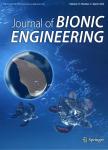Bio-inspired Design and Inverse Kinematics Solution of an Omnidirectional Humanoid Robotic Arm with Geometric and Load Capacity Constraints
作者机构:College of Intelligence Science and TechnologyNational University of Defense TechnologyChangshaChina
出 版 物:《Journal of Bionic Engineering》 (仿生工程学报(英文版))
年 卷 期:2024年第21卷第2期
页 面:778-802页
核心收录:
学科分类:080202[工学-机械电子工程] 08[工学] 0804[工学-仪器科学与技术] 0805[工学-材料科学与工程(可授工学、理学学位)] 0802[工学-机械工程] 0811[工学-控制科学与工程]
基 金:funded by the National Natural Science Foundation of China(NO.52175069)
主 题:Humanoid robotic arm Bio-inspired design Inverse kinematics solution Load capacity constraint Geometric constraint
摘 要:Inspired by the driving muscles of the human arm,a 4-Degree of Freedom(DOF)concentrated driving humanoid robotic arm is proposed based on a spatial double parallel four-bar *** four-bar mechanism design reduces the inertia of the elbow-driving unit and the torque by 76.65%and 57.81%,*** the human pose regulation strategy that the human arm picks up a heavy object by adjusting its posture naturally without complicated control,the robotic arm features an integrated position-level closed-form inverse solution method considering both geometric and load capacity *** method consists of a geometric constraint model incorporating the arm angle(φ)and the Global Configuration(GC)to avoid joint limits and singularities,and a load capacity model to constrain the feasible domain of the arm ***,trajectory tracking simulations and experiments are conducted to validate the feasibility of the proposed inverse solution *** simulated maximum output torque,maximum output power and total energy consumption of the robotic arm are reduced by up to 2.0%,13.3%,and 33.3%,*** experimental results demonstrate that the robotic arm can bear heavy loads in a human-like posture,effectively reducing the maximum output torque and energy consumption of the robotic arm by 1.83%and 5.03%,respectively,while avoiding joints beyond geometric and load capacity *** proposed design provides a high payload–weight ratio and an efficient pose control solution for robotic arms,which can potentially broaden the application spectrum of humanoid robots.



